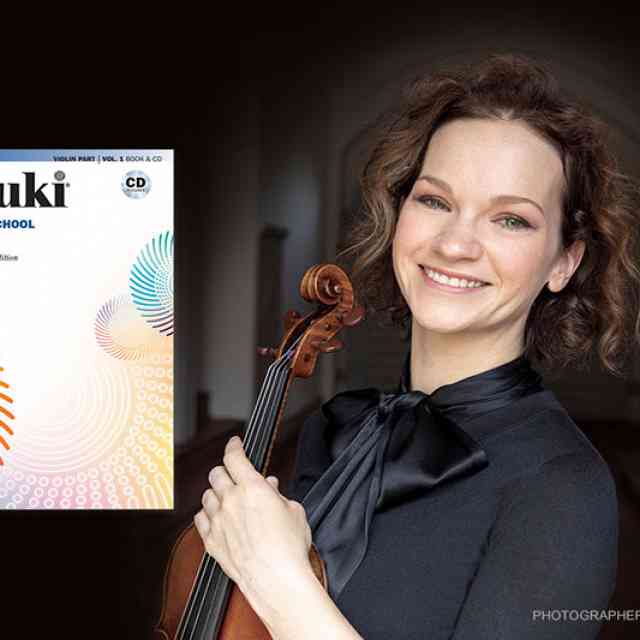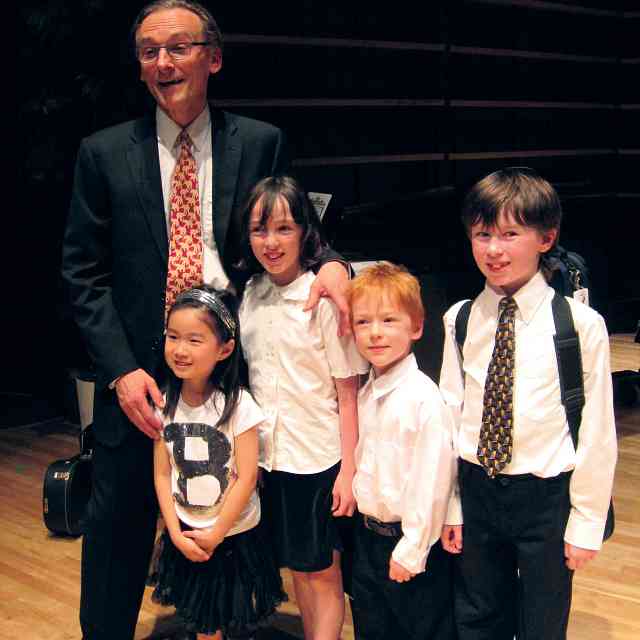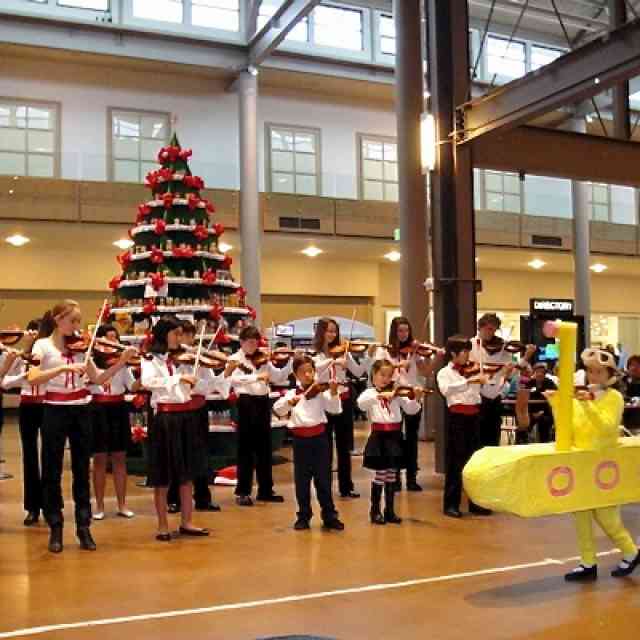When you hear “Ferguson, Missouri,” what is the first thing that comes to your mind? Do you think of young children playing the violin and cello or a vibrant community that comes together to make music and support each other? Do you think of a community that is devoted to peace and education? My guess is that, if you are honest, those were not your first images of the small suburb of St. Louis, Missouri, where my program, Suzuki Harmony STL, is located.
The media has portrayed Ferguson as a place riddled with crime and rioting. In reality, Ferguson is filled with families that want the best for their children. Many families in this predominantly Black suburb of St. Louis actively seek out ways to make a difference in their community and support each other. National and worldwide attention was brought to Ferguson after the murder of Michael Brown in 2014. Brown’s death helped fuel the Black Lives Matter movement, which had already begun with George Zimmerman’s acquittal in the shooting death of Trayvon Martin. While the media attention is no longer spotlighting this town, the residents in and around Ferguson are still advocating for change and opportunity on many levels, including access to quality music instruction.
In the Suzuki community, we love to say “every child can.” We believe this so much that it is the title of the first SAA training course. In Ferguson and other communities like it, the phrase “every child can” comes up empty unless we intentionally make it so that every child not only can, but also has the opportunity. We must break down barriers that have been systematically placed to oppress and deprive students of color of the opportunities other children have had for decades. While there is a long way to go, Suzuki Harmony is working toward equal representation within the art of classical music.
Suzuki Harmony STL began in 2017 with the mission to provide Suzuki-based private and group lessons to students in socioeconomically disadvantaged parts of the greater St. Louis metropolitan area. We began with four violin students and are currently at capacity with a waiting list, serving more than 30 violin and cello students. Our students range in age from four to 17, 60 percent Black, 20percent Latinx, and 20 percent White or Asian. We have students from areas around North St. Louis County, including Ferguson, with six school districts represented, as well as a substantial number of home-schooled students. All but three students are on financial aid. Our community is diverse and pursues excellence in all we do.
Three families in our program spoke to what Suzuki Harmony provides to the Ferguson community. I would like to share the voices of the families that are directly impacted by the work we do and provide their perspectives as to the benefit and importance access to music has in their lives. James and Miquilaue Young are parents to two of the first Suzuki Harmony STL students. James is a music teacher in the public schools and a Suzuki Harmony board member and group class teacher. Miquilaue is an author and homeschools their seven children. Munaba Nasiiro is a chiropractor and mother of two Suzuki Harmony students. Lashonda Lockhart homeschools her four children, two of whom are enrolled in Suzuki Harmony. Their voices and perspectives will be shared throughout the remainder of this article.
First, they were asked, “What does it mean for Ferguson to have a program like this and what hopes do you have for the community?” The first comment from all the parents was about accessibility. The next nearest Suzuki program is 15 miles away and can take roughly 30 minutes (more in evening rush hour) to get to from the university that houses Suzuki Harmony. While that may not seem terribly far, because of representation, time, schedules, transportation, and finances, it is a world away. In our program, students are able to see peer musicians who look like them when they come to group class. We learn music by composers who are not White. They get the opportunity to explore their own creativity by composing and improvising their own music and then performing it at recitals. The Young family noted that being present in the community is of great importance because they have seven children, and a trip outside of their community would not happen; it simply wouldn’t be possible.
The Youngs further explained that when access to quality programs is provided, value is added to the community rather than taken to another community. This allows the area to thrive. When programs like this stand the test of time, legacies are built. Historically, there has been a disproportionate lack of availability to resources in Ferguson and the surrounding areas. This extends far beyond the arts, but is perhaps most clearly seen with the lack of access to arts programs many communities take for granted. In the course of three years, we have had students attend Suzuki workshops and participate in honors orchestras in the area. While they learned so much and had a lot of fun, it is impossible for the majority of my students to attend such workshops and honors orchestras without recognizing that they are one of, if not the only, musician of color. On multiple occasions, I have had students comment that they were “the only Brown kid there!” The first student to draw attention to this was nine years old. While I am thankful for the brilliant Suzuki community in St. Louis, there is a definite disparity in who can access these opportunities. I do not point this out to bring shame or guilt. I am sharing the perspective of my students because they matter, their futures matter, and accessibility matters because it changes lives.
Diversity and representation are critical components to our program’s community. Each of the families I spoke with mentioned the importance of this. When our students play in group class or perform for recitals, they see other children who look like them doing the same thing they are doing. They see older Black and Latinx children performing works of music that are much harder than what they are playing and gives them the hope that they can do the same if they work hard. While we want to improve the representation of BIPOC in our staff (and this is something we are actively seeking out), our students are able to see themselves through more advanced students. Some of our students have also had the opportunity to play with internationally known group Black Violin, composed of performers Kev Marcus and Wil Baptiste. Experiences like this are so beneficial because my students can see their own stories reflected in Kev’s and Wil’s. Fostering a community where my students have role models with the same color skin as them has been a priority. We are constantly seeking out more opportunities for our students to learn from and be inspired by musicians of color so they can know it is possible for them too. While I have my students listen to the Suzuki albums, I also give lists of performers and composers who are not White. If 100 percent of my students were White, I would continue to do this. Decolonizing what we listen to is what our entire community and country should aspire to.
When asked what the benefits the parents have personally seen in their children’s lives because of the programs Suzuki Harmony STL offers, the answers were incredibly varied and inspiring. Emuna Young, James and Miquilaue’s daughter, has shown incredible growth. Three years ago, at our first recital, she would not play in front of the audience. She had had a negative experience prior to this recital, and the stage fright was too overwhelming. Fast forward a year, and she got on stage and played beautifully, performing with her father, who is a classical guitarist. Emuna has since played masterfully in every recital.
Emuna’s experience may not be every student’s experience, but the Youngs note the victory she felt is one of the reasons music is so important to their family. They also see how their children feel when something for which they have worked diligently finally clicks and they have a sense of accomplishment. These are teachable moments every parent desires for their child. Students and parents are able to see together that their hard work does pay off. The Young and Lockhart families see the benefits as long lasting—a deposit into the future. Mrs. Lockhart described their life as a “musical” because their lives revolve around music and the lessons it provides. Both families come from legacies of musicians and their desire is that their children will continue that and take it as their own.
Mr. Young, as a music teacher, says he wanted the benefits the Suzuki method offers of starting his children at a young age. He also appreciates that the Suzuki method meets families and children where they are and uses creativity to engage young musicians. Mr. Young’s grandmother was the first African American music teacher in the Ferguson-Florissant School District, and her legacy is a daily reminder of the impact music has; it is far reaching not just geographically, but generationally.
Lastly, I asked families why they have stuck with lessons through the COVID-19 pandemic, especially after finances have been affected by the economic uncertainty. Mrs. Nasiiro said, “We have stuck with lessons because it is one tiny bit of our ‘normal.’ Violin was there before the pandemic and has continued to be there,” and, “Even through the pandemic, the lessons have remained available and accessible.” The Young family noted that they stuck with lessons because they want to make sure that even during this time, their children continue to grow in their musical abilities. They recognize that stagnation is detrimental in the long run to motivation and musical ability.
While the pandemic provided an unanticipated hurdle, Suzuki Harmony was already committed to making things accessible, so providing lessons through this time was a given. To create success for our students and establish a legacy in our community, consistency is a top priority. Thankfully, we have not lost any students during this time and we will continually seek ways to engage our students, no matter what the world looks like.
Since speaking at one of the SAA’s open Zoom calls, I have been approached by many people asking what they can do or what the next steps are to continuing this work. If you are a teacher looking to contribute, first, listen. Why do we as Suzuki teachers believe listening is so important? It allows our students to internalize the music. White teachers, we need to internalize the things our colleagues of color are saying. Read, listen to podcasts, Google. Do the work and don’t ask for it to be done for you by BIPOC. Elevate their voices.
Secondly, remember that this work is not done overnight; we must keep practicing. Suzuki Harmony STL and other organizations doing similar work will continue to need support a year from now, five years from now, 50 years from now. As the Young family pointed out, when Michael Brown was murdered, there were many organizations and people that came to Ferguson and promised many things. Many of those organizations and people are no longer involved. I often remind my students that there are just some passages they will always have to practice to maintain proficiency. Anti-racism work is not a temporary project; it is a life-long journey to be practiced every day that ends in “y.”
Next, consider sponsoring a student, either in an organization already doing this work or in your own studio. Could your studio families pool money together to sponsor a child in your area? In doing so, you are building character in your studio by engaging the community. Start small; don’t let the enormity of the problem paralyze you from taking steps. Give money to anti-racist organizations. This list could go on; get creative and reach out if you need more ideas!
Finally, repeat. Why do we have our students review and repeat things so many times? Because that is what makes it stick. And as you repeat, be open to mindsets that still need to change. A beautiful heart is not stagnant, it is malleable. It is one that pushes through the discomfort and thinks of others. As Suzuki teachers, we have built our careers on the ideals of a man who believed in inclusion, character, community, and peace. We cannot let comfort and complacency mar his legacy. Let’s advocate and make the world more beautiful together.
You can find more information about Suzuki Harmony STL and donate at suzukiharmonystl.org










